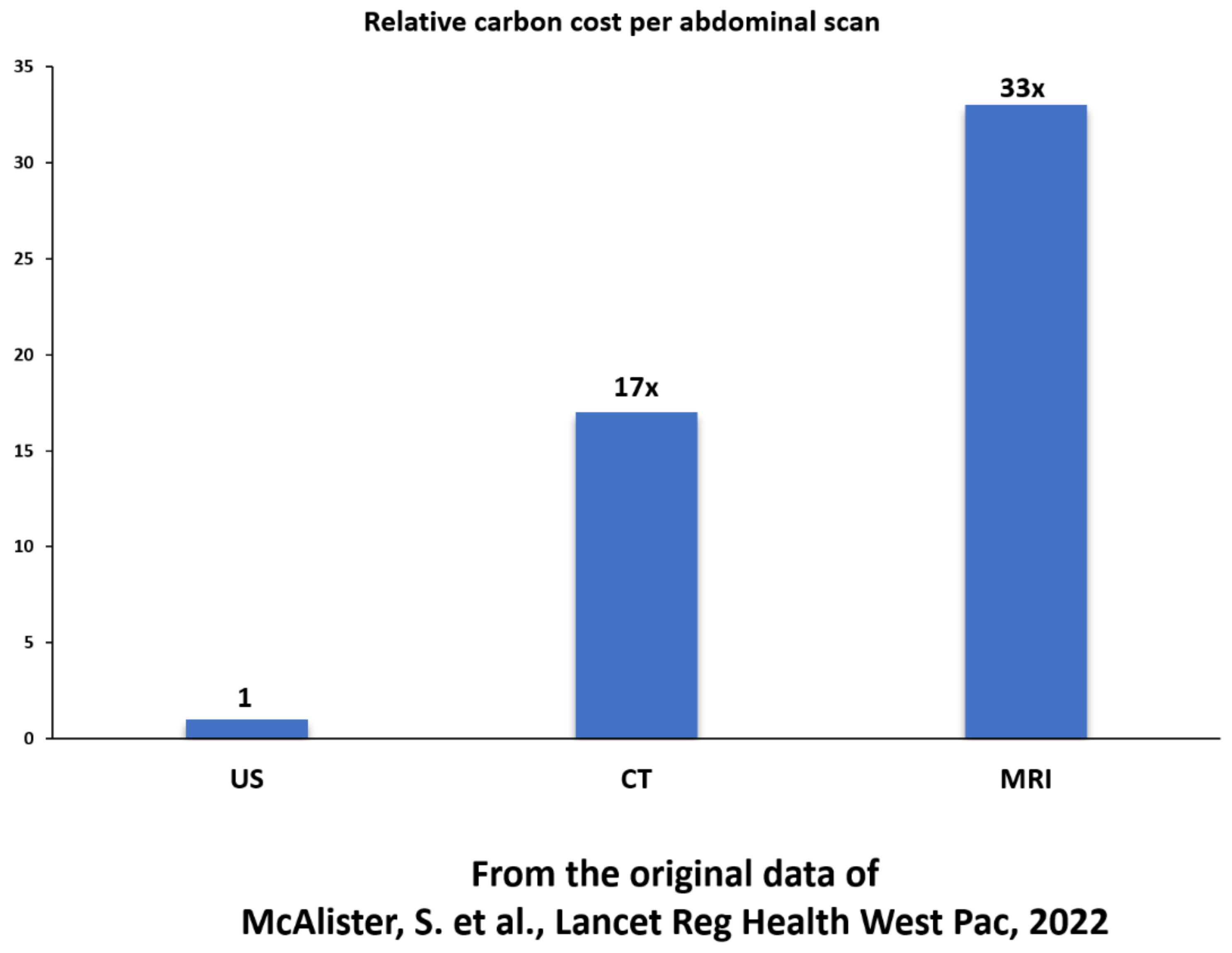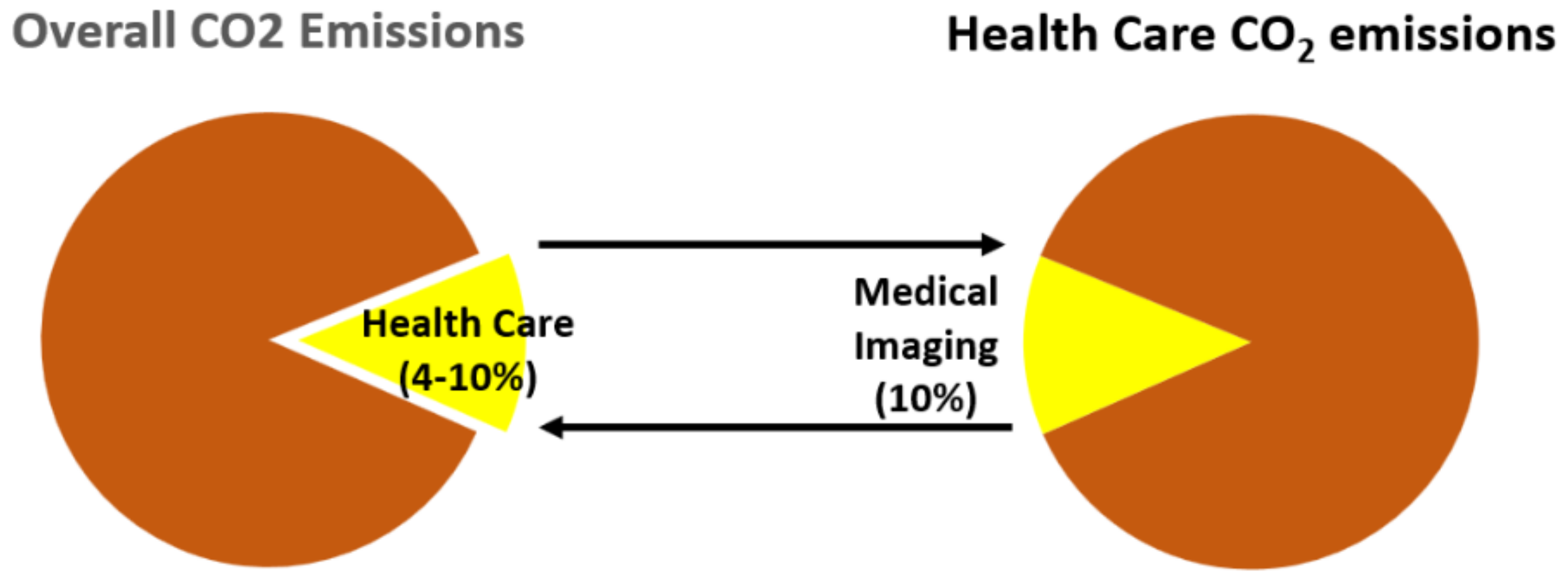Climate Change, Carbon Dioxide Emissions, and Medical Imaging Contribution
Abstract
1. Introduction
2. Climate Changes and Carbon Dioxide
3. The Environmental Footprint of Imaging Examinations
4. Opportunity to Change
5. The Road to Environmental Sustainability in Medical Imaging
- As prescribers or practitioners, we need to know what our carbon impact is (the exact environmental cost of each imaging examination);
- There is no right or wrong absolute value of carbon cost, but certainly, the wrong value is the one we ignore;
- Through its effects on climate change, carbon is a cost taken up by society;
- Through its effects on climate change, carbon is a health risk taken up by the entire population, including those unexposed to testing;
- Like radiation, carbon cost should always be justified;
- Like radiation, carbon cost should always be optimized;
- Like radiation, the responsibility for inappropriate carbon costs should be that of both the prescriber and the practitioner;
- If we include carbon cost in our imaging cost-benefit balance, the industry will start on the road to achieving the same image quality with less carbon cost;
- Carbon is important in all fields of the economy, from housing to energy and transportation, and also in medicine to preserve the current standard of care and environmental integrity for future generations;
- Prescribing an imaging test is a medical and social act [43].
6. Conclusions
Author Contributions
Funding
Institutional Review Board Statement
Informed Consent Statement
Data Availability Statement
Conflicts of Interest
References
- Picano, E.; Vañó, E.; Rehani, M.M.; Cuocolo, A.; Mont, L.; Bodi, V.; Bar, O.; Maccia, C.; Pierard, L.; Sicari, R.; et al. The appropriate and justified use of medical radiation in cardiovascular imaging: A position document of the ESC Associations of cardiovascular imaging, Percutaneous cardiovascular interventions, and electrophysiology. Eur. Heart J. 2014, 35, 665–672. [Google Scholar] [CrossRef]
- Knuuti, J.; Wijns, W.; Saraste, A.; Capodanno, D.; Barbato, E.; Funck-Brentano, C.; Prescott, E.; Storey, R.; Deaton, C.; Cuisset, T.; et al. ESC Scientific Document Group 2019 ESC Guidelines for the diagnosis and management of chronic coronary syndromes. Eur. Heart J. 2020, 4, 407–477. [Google Scholar] [CrossRef] [PubMed]
- Gulati, M.; Levy, P.D.; Mukherjee, D.; Amsterdam, E.; Bhatt, D.L.; Birtcher, K.K.; Blankstein, R.; Boyd, J.; Bullock-Palmer, R.P.; Conejo, T.; et al. AHA/ACC/ASE/CHEST/SAEM/SCCT/SCMR guideline for the evaluation and diagnosis of chest pain: A report of the American College of Cardiology/American Heart Association Joint Committee on Clinical Practice Guidelines. J. Am. Coll. Cardiol. 2021, 78, e187–e285. [Google Scholar] [CrossRef] [PubMed]
- Slanetz, P.J.; Schoen, J.H.; Maturen, K.E.; Zigmund, B. Green Is Rad: Engaging Radiologists in Building More Sustainable Radiology Practices. J. Am. Coll. Radiol. 2022, 6, S1546. [Google Scholar] [CrossRef]
- Bhatnagar, A. Environmental Determinants of Cardiovascular Disease. Circ. Res. 2017, 121, 162–180. [Google Scholar] [CrossRef] [PubMed]
- Münzel, T.; Hahad, O.; Sørensen, M.; Lelieveld, J.; Duerr, G.D.; Nieuwenhuijsen, M.; Daiber, A. Environmental risk factors and cardiovascular diseases: A comprehensive expert review. Cardiovasc. Res. 2022, 118, 2880–2902. [Google Scholar] [CrossRef]
- Romanello, M.; McGushin, A.; Di Napoli, C.; Drummond, P.; Hughes, N.; Jamart, L.; Kennard, H.; Lampard, P.; Rodriguez, B.S.; Arnell, N.; et al. The 2021 report of the Lancet Countdown on health and climate change: Code red for a healthy future. Lancet 2021, 398, 1619–1662. [Google Scholar] [CrossRef]
- Zhao, Q.; Guo, Y.; Ye, T.; Gasparrini, A.; Tong, S.; Overcenco, A.; Urban, A.; Schneider, A.; Entezari, A.; Vicedo-Cabrera, A.M.; et al. Global, regional, and national burden of mortality associated with non-optimal ambient temperatures. Lancet Planet. Health 2021, 5, e415–e425. [Google Scholar] [CrossRef] [PubMed]
- Von Schneidemesser, E.; Monks, P.S.; Allan, J.D.; Bruhwiler, L.; Forster, P.; Fowler, D.; Lauer, A.; Morgan, W.T.; Paasonen, P.; Righi, M.; et al. Chemistry and the linkages between air quality and climate change. Chem. Rev. 2015, 115, 3856–3897. [Google Scholar] [CrossRef]
- Niklas Hagelberg UN Environment l Program. Air Pollution and Climate Change. Two Sides of the Same Coin. 23 April 2019. Available online: www.unep.org/news-and-stories/story/air-pollution-and-climate-change-two-sides-same-coin (accessed on 20 November 2022).
- NASA. Global Climate Change. Carbon dioxide. Latest Measurement June 2022. Carbon Dioxide|Vital Signs—Climate Change: Vital Signs of the Planet. Available online: nasa.gov (accessed on 20 November 2022).
- Montzka, S. The NOAA Annual Greenhouse Gas Index (AGGI). NOAA Global Monitoring Laboratory Website. Available online: https://gml.noaa.gov/aggi/aggi.html (accessed on 2 December 2022).
- Pörtner, H.-O.; Roberts, D.; Tignor, M.; Poloczanska, E.; Mintenbeck, K.; Alegría, A.; Craig, M.; Langsdorf, S.; Löschke, S.; Möller, V.; et al. Climate Change 2022: Impacts, Adaptation and Vulnerability; IPCC Sixth Assessment Report; IPCC: Geneva, Switzerland, 2022. [Google Scholar]
- Watts, N.; Amann, M.; Arnell, N.; Ayeb-Karlsson, S.; Belesova, K.; Berry, H.; Bouley, T.; Boykoff, M.; Byass, P.; Cai, W.; et al. The 2018 report of the Lancet Countdown on health and climate change: Shaping the health of nations for centuries to come. Lancet 2018, 392, 2479–2514. [Google Scholar] [CrossRef]
- Khraishah, H.; Alahmad, B.; Ostergard, R.L.; AlAshqar, A.; Albaghdadi, M.; Vellanki, N.; Chowdhury, M.M.; Al-Kindi, S.G.; Zanobetti, A.; Gasparrini, A.; et al. Climate change and cardiovascular disease: Implications for global health. Nat. Rev. Cardiol. 2022, 19, 798–812. [Google Scholar] [CrossRef] [PubMed]
- Friedman, L. Democrats designed the climate law to be a game-changer. The New York Times, 22 August 2022. [Google Scholar]
- Stern, M.J. Justice Alito Declares “Carbon Dioxide Is Not a Pollutant” FEB 13, 2017. Available online: Slate.com/news-and-politics (accessed on 20 November 2022).
- Marwick, T.H.; Buonocore, J. Environmental impact of cardiac imaging tests for the diagnosis of coronary artery disease. Heart 2011, 97, 1128–1131. [Google Scholar] [CrossRef] [PubMed]
- Braga, L.; Vinci, B.; Leo, C.G.; Picano, E. The true cost of cardiovascular imaging: Focusing on downstream, indirect, and environmental costs. Cardiovasc. Ultrasound 2013, 11, 10. [Google Scholar] [CrossRef] [PubMed]
- Martin, M.; Mohnke, A.; Lewis, G.M.; Dunnick, N.R.; Keoleian, G.; Maturen, K.E. Environmental Impacts of Abdominal Imaging: A Pilot Investigation. J. Am. Coll. Radiol. 2018, 15, 1385–1393. [Google Scholar] [CrossRef] [PubMed]
- McAlister, S.; McGain, F.; Petersen, M.; Story, D.; Charlesworth, K.; Ison, G.; Barratt, A. The carbon footprint of hospital diagnostic imaging in Australia. Lancet Reg. Health West Pac. 2022, 24, 100459. [Google Scholar] [CrossRef]
- Heye, T.; Knoerl, R.; Wehrle, T.; Mangold, D.; Cerminara, A.; Loser, M.; Plumeyer, M.; Degen, M.; Lüthy, R.; Brodbeck, D.; et al. The Energy Consumption of Radiology: Energy- and Cost-saving Opportunities for CT and MRI Operation. Radiology 2020, 295, 593–605. [Google Scholar] [CrossRef]
- Esmaeili, A.; McGuire, C.; Overcash, M.; Ali, K.; Soltani, S.; Twomey, J. Environmental impact reduction as a new dimension for quality measurement of healthcare services. Int. J. Health Care Qual. Assur. 2018, 31, 910–922. [Google Scholar] [CrossRef]
- Pichler, P.; Jaccard, I.; Weisz, U.; Weisz, H. International comparison of health care carbon footprints. Environ. Res. Lett. 2019, 14, 064004. [Google Scholar] [CrossRef]
- Eckelman, M.J.; Sherman, J. Environmental Impacts of the U.S. Health Care System and Effects on Public Health. PLoS ONE 2016, 11, e0157014. [Google Scholar] [CrossRef]
- Sustainable Development Unit. UK National Health Service 2016 Carbon Footprint Updatefor NHS in England; Sustainable Development Unit: Cambridge, UK, 2015. [Google Scholar]
- Malik, A.; Lenzen, M.; McAlister, S.; McGain, F. The carbon footprint of Australian health care. Lancet Planet Health 2018, 2, e27–e35. [Google Scholar] [CrossRef]
- Diagnostic Imaging Market Global Forecast to 2024|MarketsandMarket. Available online: www.marketsandmarkets.com/Market-Reports/diagnostic-imaging-market-411.html (accessed on 20 November 2022).
- Kouropoulos, G.P. A predictive model for the estimation of carbon dioxide emissions of magnetic resonance imaging units and computed tomography scanners. J. Urban Environ. Eng. 2018, 12, 172–187. [Google Scholar] [CrossRef]
- Chaudhry, S.M.; Ahmed, R.; Shafiullah, M.; Duc Huynh, T.L. The impact of carbon emissions on country risk: Evidence from the G7 economies. J. Environ. Manag. 2020, 265, 110533. [Google Scholar] [CrossRef] [PubMed]
- Woolen, S.A.; Kim, C.J.; Hernandez, A.M.; Becker, A.; Martin, A.J.; Kuoy, E.; Pevec, W.C.; Tutton, S. Radiology Environmental Impact: What Is Known and How Can We Improve? Acad. Radiol. 2022, 15, S1076–S6332. [Google Scholar] [CrossRef] [PubMed]
- Brünjes, R.; Hofmann, T. Anthropogenic gadolinium in freshwater and drinking water systems. Water Res. 2020, 182, 115966. [Google Scholar] [CrossRef]
- Jouni, H.; Askew, J.W.; Crusan, D.J.; Miller, T.D.; Gibbons, R.J. Temporal trends of single-photon emission computed tomography myocardial perfusion imaging in patients without prior coronary artery disease: A 22-year experience at a tertiary academic medical center. Am. Heart J. 2016, 176, 127–133. [Google Scholar] [CrossRef]
- Picano, E. Sustainability of medical imaging. BMJ 2004, 328, 578–580. [Google Scholar] [CrossRef]
- Schoen, J.; McGinty, G.B.; Quirk, C. Radiology in Our Changing Climate: A Call to Action. J. Am. Coll. Radiol. 2021, 18, 1041–1043. [Google Scholar] [CrossRef]
- Carpeggiani, C.; Marraccini, P.; Morales, M.A.; Prediletto, R.; Landi, P.; Picano, E. Inappropriateness of cardiovascular radiological imaging testing; a tertiary care referral center study. PLoS ONE 2013, 8, e81161. [Google Scholar] [CrossRef]
- Qin, C.; Murali, S.; Lee, E.; Supramaniam, V.; Hausenloy, D.J.; Obungoloch, J.; Brecher, J.; Lin, R.; Ding, H.; Akudjedu, T.N.; et al. Sustainable low-field cardiovascular magnetic resonance in changing healthcare systems. Eur. Heart J. Cardiovasc. Imaging 2022, 23, e246–e260. [Google Scholar] [CrossRef]
- Hirschfeld, J.W., Jr.; Ferrari, V.A.; Bengel, F.M.; Bergersen, L.; Chambers, C.E.; Einstein, A.J.; Eisenberg, M.J.; Fogel, M.A.; Gerber, T.C.; Haines, D.E.; et al. ACC/HRS/NASCI/SCAI/SCCT Expert consensus document on optimal use of ionizing radiation in cardiovascular imaging: Best practices for safety and effectiveness. J. Am. Coll. Cardiol. 2018, 71, e283–e351. [Google Scholar] [CrossRef]
- Smith-Bindman, R.; Kwan, M.L.; Marlow, E.; Theis, M.K.; Bolch, W.; Cheng, S.Y.; Bowles, E.J.A.; Duncan, J.R.; Greenlee, R.T.; Kushi, L.H.; et al. Trends in Use of Medical Imaging in US Health Care Systems and Ontario, Canada, 2000–2016. JAMA 2019, 322, 843–856. [Google Scholar] [CrossRef] [PubMed]
- Ciampi, Q.; Antonini-Canterin, F.; Barbieri, A.; Barchitta, A.; Benedetto, F.; Cresti, A.; Miceli, S.; Monte, I.; Petrella, L.; Trocino, G.; et al. Reshaping of Italian Echocardiographic Laboratories Activities during the Second Wave of COVID-19 Pandemic and Expectations for the Post-Pandemic Era. J. Clin. Med. 2021, 10, 3466. [Google Scholar] [CrossRef] [PubMed]
- Global Electronic Council. State of Sustainability Research. Medical Imaging Equipment. Prepared for Medical Equipment Proactive Alliance; Global Electronic Council: Portland, OR, USA, 2022. [Google Scholar]
- NHS Sustainable Development Unit. Sustainability Survey. 1 February 2022. Available online: www.ipsos.com/en-uk/nhs-sdu-sustainability-survey (accessed on 20 November 2022).
- Picano, E. Economic, ethical, and environmental sustainability of medical imaging. Eur. Heart J. 2022, ehac716. [Google Scholar] [CrossRef] [PubMed]
- Schoen, J.; Marrero-Gonzalez, A. Climate Change and Radiology. Climate Change and Radiology | American College of Radiology. Available online: acr.org (accessed on 20 November 2022).
- Dzau, V.J.; Levine, R.; Barrett, G.; Witty, A. Decarbonizing the U.S. Health Sector—A Call to Action. N. Engl. J. Med. 2021, 385, 2117–2119. [Google Scholar] [CrossRef] [PubMed]
- Baron, R.J.; Lynch, T.J.; Rand, K. Lessons From the Choosing Wisely Campaign's 10 Years of Addressing Overuse in Health Care. JAMA Health Forum 2022, 3, e221629. [Google Scholar] [CrossRef]
- Picano, E. Air cardiology is now on air. Eur. Heart J. 2021, 42, 961–962. [Google Scholar] [CrossRef]



Disclaimer/Publisher’s Note: The statements, opinions and data contained in all publications are solely those of the individual author(s) and contributor(s) and not of MDPI and/or the editor(s). MDPI and/or the editor(s) disclaim responsibility for any injury to people or property resulting from any ideas, methods, instructions or products referred to in the content. |
© 2022 by the authors. Licensee MDPI, Basel, Switzerland. This article is an open access article distributed under the terms and conditions of the Creative Commons Attribution (CC BY) license (https://creativecommons.org/licenses/by/4.0/).
Share and Cite
Picano, E.; Mangia, C.; D’Andrea, A. Climate Change, Carbon Dioxide Emissions, and Medical Imaging Contribution. J. Clin. Med. 2023, 12, 215. https://doi.org/10.3390/jcm12010215
Picano E, Mangia C, D’Andrea A. Climate Change, Carbon Dioxide Emissions, and Medical Imaging Contribution. Journal of Clinical Medicine. 2023; 12(1):215. https://doi.org/10.3390/jcm12010215
Chicago/Turabian StylePicano, Eugenio, Cristina Mangia, and Antonello D’Andrea. 2023. "Climate Change, Carbon Dioxide Emissions, and Medical Imaging Contribution" Journal of Clinical Medicine 12, no. 1: 215. https://doi.org/10.3390/jcm12010215
APA StylePicano, E., Mangia, C., & D’Andrea, A. (2023). Climate Change, Carbon Dioxide Emissions, and Medical Imaging Contribution. Journal of Clinical Medicine, 12(1), 215. https://doi.org/10.3390/jcm12010215






